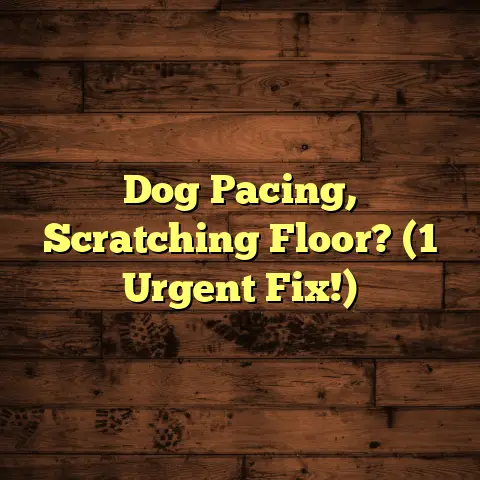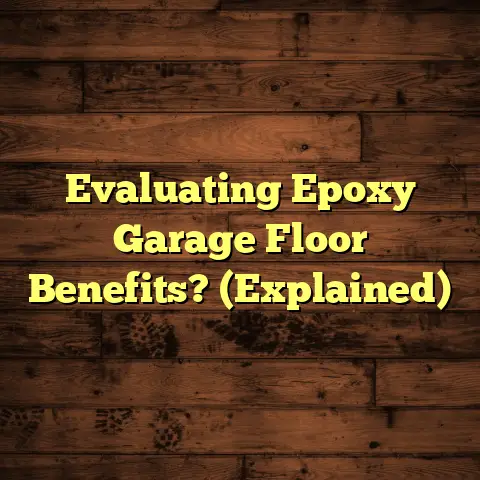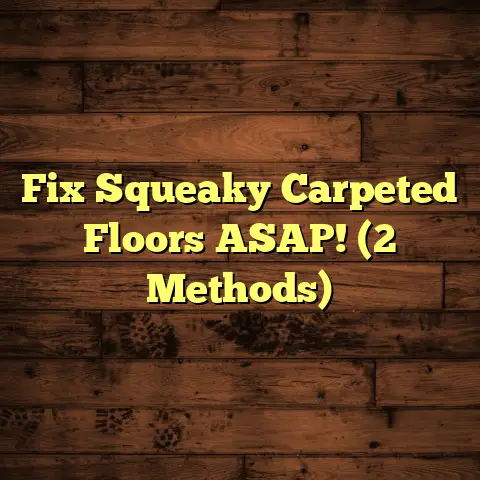Crawl Space Concrete Cost? (Get Quote Now!)
Section 1: Understanding Crawl Spaces
So, what is a crawl space, exactly? It’s that unfinished area between the ground and the first floor of your home. Think of it as a mini-basement, but usually not tall enough to stand in.
Purpose of a Crawl Space
Its main purpose is to provide access to plumbing, electrical wiring, and sometimes HVAC systems. It also helps elevate your home off the ground, which can be crucial in areas prone to flooding.
Common Characteristics
Crawl spaces are typically 1 to 3 feet high, making it a tight squeeze. Access is usually through a small door or hatch, often outside your house. Environmentally, they can be damp, dark, and prone to temperature swings.
Potential Issues
Moisture is a biggie. Standing water, condensation… it’s not pretty. Pest infestations are also common – think rodents, insects, and termites. Structural concerns can arise from moisture damage leading to wood rot.
Section 2: The Importance of Concrete in Crawl Spaces
Why concrete, you ask? Well, it’s a game-changer for crawl spaces. It acts as a barrier against moisture, pests, and even radon gas.
Benefits of Concrete
Concrete significantly reduces moisture vapor transmission. It helps prevent pests from burrowing into your home’s foundation. Plus, it adds structural support, preventing settling and cracking.
Enhancing Durability
Concrete flooring makes the crawl space much more durable. It protects against wear and tear from foot traffic and storage. It also makes maintenance a whole lot easier.
Dirt vs. Gravel vs. Concrete
Dirt floors are the worst. They offer zero protection against moisture and pests. Gravel is a slight improvement, but it doesn’t fully block moisture. Concrete is the gold standard, offering superior protection and longevity.
I’ve seen firsthand how a concrete floor can transform a damp, unpleasant crawl space into a dry, usable area. It’s an investment that pays off in the long run.
Section 3: Cost Breakdown of Crawl Space Concrete Installation
Okay, let’s talk numbers. What can you expect to pay for concrete? The cost varies, but here’s a breakdown of what goes into it.
Material Costs
- Concrete: The type of concrete matters. A standard mix costs $100-$150 per cubic yard.
- Additives: Waterproofing agents, like sealants, can add $50-$100 per gallon.
- Reinforcements: Wire mesh or rebar costs about $0.50-$1.00 per square foot.
Labor Costs
- Average Rates: Contractors typically charge $4-$8 per square foot for labor.
- Regional Variations: Labor rates can vary widely. Expect higher costs in urban areas. For example, in California, rates might be 20-30% higher than in the Midwest.
Additional Costs
- Excavation: If the crawl space needs leveling, excavation can add $1-$3 per square foot.
- Drainage Solutions: Installing a sump pump can cost $500-$1,500.
- Vapor Barriers: A 6-mil polyethylene vapor barrier costs about $0.15-$0.30 per square foot.
Factors Influencing Total Cost
- Size: The bigger the crawl space, the more materials and labor are needed.
- Accessibility: Tight spaces make it harder to work, increasing labor costs.
- Local Rates: Contractor rates vary by region, so get multiple quotes.
Here’s a handy table to give you a clearer picture:
| Cost Category | Average Cost per Square Foot | Notes |
|---|---|---|
| Materials | $2 – $4 | Includes concrete, additives, vapor barrier, and reinforcements |
| Labor | $4 – $8 | Varies based on contractor rates and complexity of the job |
| Excavation | $1 – $3 | If needed for leveling or drainage |
| Drainage Solutions | $0.50 – $1.50 | Additional cost for sump pump installation or other drainage systems |
| Total Estimated Cost | $7.50 – $16.50 | Range based on all factors considered |
Important Note: These are just estimates. Always get a detailed quote from a qualified contractor!
Section 4: Comparing Crawl Space Concrete Costs by Region
Location, location, location! It affects everything, including concrete costs. Let’s see how prices vary across the U.S.
Regional Variations
- Northeast: High labor costs drive up prices. Expect to pay $10-$20 per square foot.
- South: More moderate costs, around $7-$15 per square foot.
- Midwest: Generally lower costs, ranging from $6-$12 per square foot.
- West: High demand and labor costs can push prices to $12-$22 per square foot.
Specific Examples
- California: Due to high labor and material costs, expect to pay $14-$22 per square foot.
- Texas: More affordable, with costs around $8-$16 per square foot.
- Florida: Similar to Texas, ranging from $7-$15 per square foot.
- Ohio: One of the more affordable states, with costs around $6-$12 per square foot.
Regional Regulations and Climate
- Coastal Areas: Higher costs due to stricter building codes and potential flood risks.
- Cold Climates: May require insulated concrete to prevent freezing and cracking.
- Radon-Prone Areas: Radon mitigation systems add to the overall cost.
Section 5: Getting Accurate Quotes for Crawl Space Concrete Work
Ready to get some quotes? Here’s how to do it right.
Step-by-Step Guide
- Assess Your Crawl Space: Measure the area, note any issues like standing water or pests.
- Gather Information: Know the dimensions, current condition, and your desired finish.
- Contact Contractors: Get at least three quotes from reputable local contractors.
- Evaluate Quotes: Compare prices, materials, and warranties.
- Select a Contractor: Choose based on experience, reviews, and overall value.
Information to Gather
- Dimensions: Length, width, and height of the crawl space.
- Current Condition: Photos or videos of any existing problems.
- Desired Finish: Smooth, brushed, or sealed concrete.
Tips for Evaluating Quotes
- Check References: Ask for and contact previous clients.
- Read Reviews: Look for online reviews on sites like Yelp or Google.
- Verify Licensing: Ensure the contractor is licensed and insured.
- Get a Written Contract: The contract should detail the scope of work, materials, and payment schedule.
Pro Tip: Don’t just go for the lowest bid. Consider the contractor’s experience and reputation.
Section 6: Long-Term Financial Considerations
Investing in crawl space concrete isn’t just about the initial cost. Think about the long-term benefits and savings.
Savings on Maintenance and Repairs
- Moisture Control: Reduces the risk of mold, mildew, and wood rot.
- Pest Prevention: Eliminates breeding grounds for pests, saving on extermination costs.
- Structural Integrity: Prevents settling and cracking, avoiding costly foundation repairs.
Enhancing Property Value
- Improved Home Health: A dry, clean crawl space improves indoor air quality.
- Increased Usable Space: The crawl space can be used for storage or even converted into a usable area.
- Higher Resale Value: A well-maintained crawl space is a selling point for potential buyers.
According to a study by Advanced Energy, sealing a crawl space can reduce energy bills by 15-25%. That adds up over time!
Section 7: Real-Life Case Studies
Let’s look at some real-world examples to see the impact of concrete.
Case Study 1: The Moisture Problem
- Homeowner: Sarah in Atlanta, GA
- Problem: Severe moisture and mold in her crawl space.
- Solution: Installed a concrete floor with a vapor barrier and sump pump.
- Results: Eliminated moisture, improved air quality, and increased her home’s value.
- Initial Cost: $8,000
- Long-Term Savings: Reduced energy bills by 20% and avoided costly mold remediation.
Case Study 2: The Pest Infestation
- Homeowner: John in Portland, OR
- Problem: Constant rodent and insect infestations in his crawl space.
- Solution: Poured a concrete floor and sealed all entry points.
- Results: Eliminated pests, improved structural integrity, and reduced allergens in his home.
- Initial Cost: $6,500
- Long-Term Savings: No more pest control services and reduced risk of structural damage.
Case Study 3: The Settling Foundation
- Homeowner: Maria in Denver, CO
- Problem: Settling foundation due to unstable soil in her crawl space.
- Solution: Installed a reinforced concrete floor to stabilize the foundation.
- Results: Stabilized the foundation, prevented further settling, and increased her home’s resale value.
- Initial Cost: $10,000
- Long-Term Savings: Avoided costly foundation repairs and increased her home’s value.
These case studies show how concrete can solve common crawl space problems. Professional installation and proper planning are key to success.
Conclusion
Alright, we’ve covered a lot! Understanding crawl space concrete costs is crucial for homeowners. It’s an investment that can protect your home, improve its value, and provide peace of mind.
Don’t wait until you have a major problem. Get quotes from qualified contractors and consider the long-term benefits. A dry, stable crawl space is a happy crawl space – and a happy home!
Ready to take the next step? Get a quote now! You’ll be glad you did.





